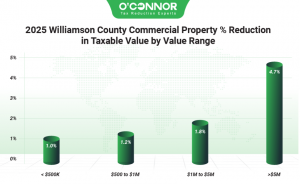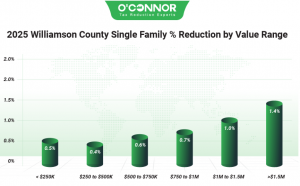Williamson County Taxpayers Saved $42.72 Million in Value with O’Connor
O'Connor discusses how Williamson County taxpayers saved $42.72 million in value with our services.
GEORGETOWN, TX, UNITED STATES, September 29, 2025 /EINPresswire.com/ --With Austin and Travis County becoming Meccas for tech, art, entertainment, and more, people from all over the globe are flocking to the area. As one of the most expensive housing markets in the country, many new arrivals and long-term residents are turning to Williamson County as a cheaper alternative, while staying in the Austin area. This has transformed the once-rural area into a suburban hub in record time, and the population is booming with more arriving every year. This has transformed the sleepy area in only a few years, leaving Williamson County in a state of flux.
One of the biggest issues facing residents and buyers is property values that continue to climb. This puts a lot of pressure on those wishing to keep their home or business. As these costs continue to shoot upward, the standard exemptions are no longer enough. Property tax appeals are becoming increasingly common, reaching record numbers in 2023. With 32% of all properties being protested in 2023, the struggle between taxpayers and the Williamson Central Appraisal District (WCAD) is coming to a head. We at O’Connor have joined the fray as well and have represented taxpayers across the county in their struggle for fair taxation. In this article, we will see the impact that appeals have had on the tax rolls and also how our clients measured up against other protestors.
Homeowners Save Double with O’Connor
According to WCAD, it is believed that 50% of homes in Williamson County were over assessed in 2025. This comes on the heels of a giant spike in value that saw home values surge by 6.3%, resulting in a total of $104.64 billion. This was on top of a 4.1% increase from 2024. While thousands of appeals were deployed, they only managed to claw back 0.6%. Most value was concentrated in homes worth between $250,000 and $500,000, which totaled $48.43 billion. This was followed by those assessed at $500,000 to $750,000 with $30.48 billion. These achieved cuts of only 0.4% and 0.6% respectively. Even the largest homes only saw a reduction of 1.4%. Homeowners that joined O’Connor got much stronger results, including a 1.3% decrease to the total. Residences worth between $250,000 and $500,000 were reduced by 1.1%.
Much like other newly suburbanized counties, such as Denton, while Williamson’s values broke the bank, it was not because of being filled with giant mansions. Huge luxury homes only contributed $176.43 million to the total. The two largest blocks with modest homes. Those between 2,000 and 3,999 square feet were responsible for $64.45 billion in value. Residences under 2,000 square feet added $32.23 billion to the total. These saw cuts of 0.6% and 0.5% respectively. Homes measured between 4,000 and 5,999 square feet added $6.74 billion after a reduction of 0.9%.
Like other up-and-coming counties, the majority of Williamson County’s residential value was built recently. 51.3%or $53.41 billion in total, was constructed between 2001 and 2020 alone, even after a reduction of .05%. About 24.1% was built from 1981 to 2000, while 16.6% came from new construction. These two timeframes saw moderate cuts of 0.5% and 0.8% respectively. New construction was the fastest-growing category, obviously, and is already responsible for $17.30 billion of the total. Land and older homes only combined for 7.9% of all residential value. This clearly illustrates a young and vibrant community.
Business Owners Saved Nearly $21 Million in Taxable Value with O’Connor
Thanks to WCAD, commercial property values in the county received an overall increase of 10% to the total. After diligent appeals resulted in a cut of 4%, the total was calculated at $36.82 billion. Like all of Texas, most commercial value was generated by properties over $1.5 million. In this case, the total was $27.74 billion. These large properties managed to land an excellent cut of 4.7% thanks to appeals. Properties assessed between $1 million and $1.5 million experienced a decrease of 1.8%, resulting in a total of $6.94 billion. We at O’Connor were able to land our business clients a bigger return, with an overall slicing of taxable worth by 5.9%. When put together, we managed to save our clients $20.91 million in value.
Like most urban, suburban, or exurban counties, Williamson’s No. 1 commercial property was apartments. Multifamily housing got a reduction of 5.2% thanks to protests, which resulted in a total of $14.12 billion. Raw land, representing limitless potential, was in the No. 2 spot with $8.18 billion after a small reduction of 1.5%. Offices totaled $5.08 billion after a reduction of 4.3%, while retail reached $4.44 billion after being protested down by 3.8%. Warehouses got a cut of 4.3%, while hotels got a decrease of 4.1%.
When it comes to the age of construction for commercial properties, there is an even greater recency bias. Buildings constructed during the 2001 to 2020 boom period are still No. 1 with $14.27 billion in value. This is followed by new construction, which already equates to 20.9% of all value, totaling $7.69 billion. These two timeframes received cuts of 4.8% and 4.3% respectively. Land was in third place, as stated above, while those constructed between 1981 and 2000 took fourth place with $6.15 billion after a strong reduction of 4.8%. The two oldest categories only combined for 1.7% of the total. This heavy weight toward recent construction and land shows just how much potential is waiting to be tapped in Williamson County.
Office Value Slashed 11%
While they may not be what people picture when they think of a suburban county, offices are increasing in importance across Williamson County. While most of this value is thanks to recent construction, it is not as lopsided as the overall commercial number. 37.3% of office value was constructed between 1981 and 2000, a total of $1.89 billion, and this was after a reduction of 4.3%. The largest chunk still came from those built between 2001 and 2020 with $2.21 billion. New construction is quickly shooting up the charts with a total of $818.30 million. These two recent categories were reduced 3.9% and 5.1% respectively, thanks to diligent property tax appeals. Office owners that signed up with O’Connor managed to nab even bigger savings, including a massive 11% reduction in the overall total. Those built between 1981 and 2000 got a 13.5% reduction, while those from 2001 to 2020 were cut by 7.3%.
WCAD divides all offices into three categories. The main one is high-rises, which totaled $3.14 billion after a reduction of 4.7%. Medical offices followed with a reduction of 3.4%, which resulted in a total of $1.04 billion. Low-rise offices finished just behind medical offices with a total of $893.45 million after a cut of 3.9%. We at O’Connor were able to reduce high-rises by 18.2%, saving owners over $1 million in taxable value.
O’Connor Cuts Warehouse Value by 20.5%
Warehouses were the fastest-growing category in all of Williamson County, adding 24.4% to their value in 2025. While appeals were predictably launched, only a savings of 4.3% was achieved for the overall total. Much of this growth was thanks to new construction, with 48.7% of all value being built after 2021. This means that $1.83 billion was just added to the books after a reduction of 3.4%. About $1.49 billion was constructed from 2001 to 2020, resulting in a total of $1.48 billion after reductions. O’Connor customers were able to slice 20.5% from the combined total of warehouses in 2025, beating the county average by 476%.
WCAD only categorized warehouses into two subtypes. Office warehouses had a grand total of $2.65 billion in value, which was achieved after a reduction of 2.1%. Mini warehouses managed a much larger cut of 9%, which brought their combined value to $1.11 billion.
About O'Connor:
O’Connor is one of the largest property tax consulting firms, representing 185,000 clients in 49 states and Canada, handling about 295,000 protests in 2024, with residential property tax reduction services in Texas, Illinois, Georgia, and New York. O’Connor’s possesses the resources and market expertise in the areas of property tax, cost segregation, commercial and residential real estate appraisals. The firm was founded in 1974 and employs a team of 1,000 worldwide. O’Connor’s core focus is enriching the lives of property owners through cost effective tax reduction.
Property owners interested in assistance appealing their assessment can enroll in O’Connor’s Property Tax Protection Program ™. There is no upfront fee, or any fee unless we reduce your property taxes, and easy online enrollment only takes 2 to 3 minutes.
Patrick O'Connor, President
O'Connor
+ + +1 713-375-4128
email us here
Visit us on social media:
LinkedIn
Facebook
YouTube
X
Legal Disclaimer:
EIN Presswire provides this news content "as is" without warranty of any kind. We do not accept any responsibility or liability for the accuracy, content, images, videos, licenses, completeness, legality, or reliability of the information contained in this article. If you have any complaints or copyright issues related to this article, kindly contact the author above.



